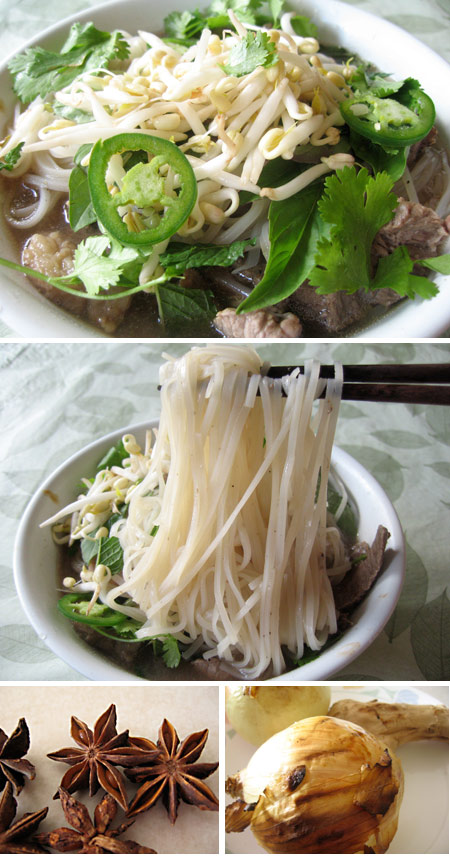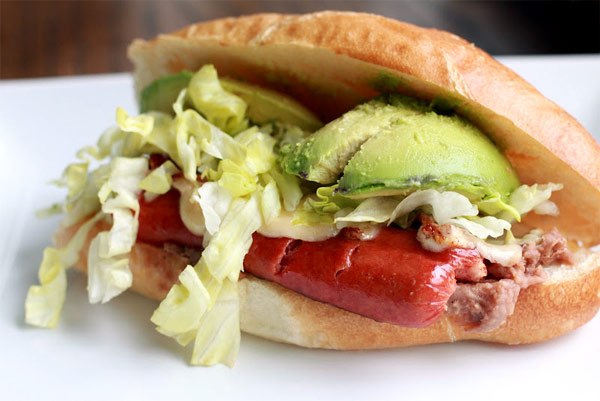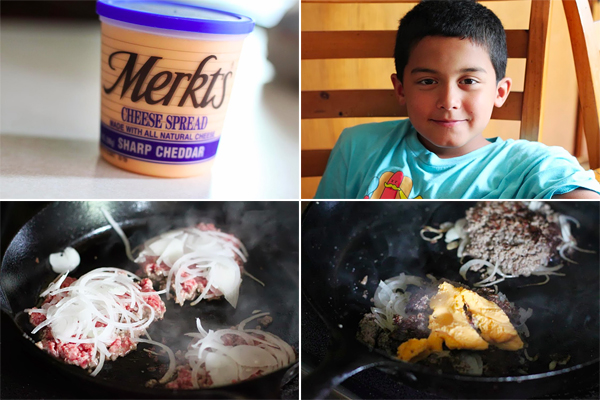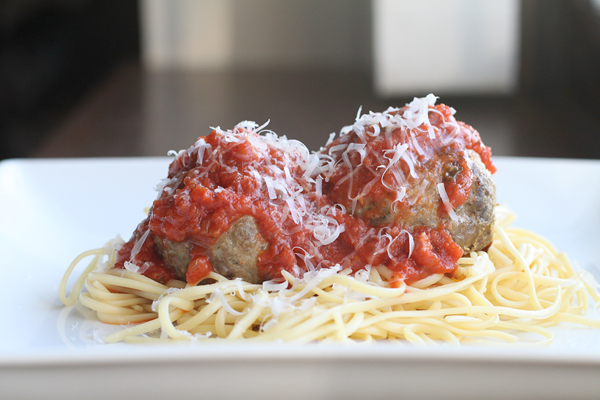
Pho Bo – Vietnamese Noodle Soup
It has been about fifteen years now since I first laid eyes on a noodle soup known as Pho. While arriving into Dallas, Texas nearly fifteen years ago, a lot was new to me then. Everything from the culture, to the cuisine, and everything in between, life sure did take on some surprises for me back then. That is where I really began my culinary adventure, trying everything from Spanish tapas, to very authentic Mexican, to the standard fare of Tex-Mex, sushi, Vietnamese and Thai cuisine, as well as the standard Indian. Rarely did I participate in the American cuisine that many of us are used to. That became somewhat boring to me as I had the opportunity to try so many different types of dishes, that I almost became picky when it came to a burger, or chicken breast on the grill.

But there was one dish, among the many, that really stood its ground. Pho. A delectable bowl of rice noodles, topped with fresh herbs, thinly sliced beef, the occasional meatball, or tripe, all submerged in possibly the best soup broth I have ever had. I encountered this Pho house, or should I say restaurant, if that, north of Dallas, in a primarily Asian neighborhood. I had many options when it came to ordering Pho. Beef, chicken, seafood, or additions such as meatballs (not your Italian meatball), tripe, or heck, even different types of meat ranging from tendon, fatty flank, or brisket. The noodles are standard. Rice noodles, cooked just right. But it is the broth. The broth is something else, and something so wonderful. You have the ability to spice it up a bit with hoisin or Sriracha sauce, a bit of black pepper, and then your toppings. Enough said. I have made this soup several times now, that I think I found the secret ingredients to make your own bowl of pho right at home.
Ingredients: (broth)
- 3 lbs of beef bones, yes, bones
- 2 medium, yellow onions
- 3-5 inch piece of ginger
- 1 lb beef rump, cut into large cubes
- 5 star anise, whole
- 1 stick of cinnamon
- 1 1/2 tbsp salt
- 1/2 tbsp black pepper
- 5 cloves, whole
- 4 tbsp white sugar
- 2 tbsp fish sauce
Ingredients: (Soup)
- 1-2 lbs of banh pho noodles
- 1/2 lb of sirloin, very thinly sliced across the grain
- 1/2 yellow onion, very thinly sliced
- Fresh mint leaves
- Fresh Thai basil
- Fresh cilantro
- Bean sprouts
- Lime wedges
- Fresh jalapeno, thinly sliced
- Hoisin Sauce (optional)
- Sriracha Sauce (optional)
Begin by firing up your grill to a high heat, and toss the two onions and ginger onto the grill, turning on occasion, for about 15 minutes, or until the outside of the onion begins to char and soften. Remove them from the grill and let cool. In the meantime, get your large soup pot ready, and place in the beef bones, covering with cold water. Bring to a boil, for about 5 minutes, then drain. Clean the pot, removing any of the impurities. Wash the bones as well and get off any of the impurities that were left behind.
Add about 28 cups (7 quarts) of water to the soup pot. Add the bones back into the pot, along with the cubed beef rump. Bring to a boil, making sure to spoon, or ladle out any of the impurities that come to the top. Remove the skin from the onion, quarter the onions and place those in the pot. Remove the skin from the ginger, flatten with the back of your knife, and place that in the pot. Add the star anise, cinnamon, sugar, salt, fish sauce, black pepper. and cloves into the mix. Give a good stir, reduce the heat to simmer, cover, and walk away for about a hour and a half.
When you are ready to return to the broth, skim off any more impurities that decided to come to the top. When making any type of broth, this is a common process, whether it be a chicken stock, or vegetable broth. Now, add some cold water to a large bowl, and remove the beef cubes from the broth into the bowl. Let this sit in the water for about 15 minutes. This keeps the beef nice and tender and will prevent it from drying out right away. Drain the beef, and place back in a covered bowl, in the refrigerator until it is time to be used again. Keep on cooking the broth on simmer for another hour and a half, about 3 hours total on broth time. You can let it go longer if you so desire.
Take in the aromatics.
Now about an hour more into the cooking, use your spoon and try to remove as much of the oil from the top as possible. Slowly and carefully. The meat and the bones generate a lot of oil. If you have time and prepare this ahead of time, you can let this completely cool, store in the refrigerator overnight, and easily skim off the solid fat in the morning, or when you are ready to use the broth. Get a large slotted spoon out and remove the bones, onions, cinnamon stick, cloves, and tendons (keep if you want), from the broth. Toss.
Build your garnish plate by adding the basil, cilantro, bean sprouts, and more. Now the time we have been waiting for. Getting the bowls ready. Bring a large pot of water to a boil. Add in about 1/2 pound of the banh pho noodles to the boiling water. Cook for about 2 minutes, just until tender, being careful not to overcook the noodles. Get your soup bowl ready, and get a large one. No skimping here. Add in your cooked noodles, top with thinly sliced pieces of sirloin, thinly sliced onion, and a couple of the meat cubes before ladling in your broth. Let this set for a few minutes as it will cook your meat. Next, build upon your noodles by adding hoisin and Sriracha if you desire, tasting your broth to make sure it is just right for you. Next add the basil, and other herbs. Give a good mix, and dig in.
Now don’t be shy with this bowl of noodles. You might sweat a bit from the heat of the jalapeno and Sriracha sauce. You will slurp and potentially get some broth on you. But I guarantee you this, that the flavors, the textures, and the overall experience will either get you making this soup more and more throughout the year, or it will have you find your local Pho shop for another delicious bowl.
Related Links:




7 Comments
Esi
Pho bo has got to be one of my most favorite soups ever
Lo - Burp! Where Food Happens
Love a good bowl of Pho. In fact, I’ve toyed with the idea of keeping some good, homemade pho stock around (since it takes a while to prep) so that we can have a bit of this lovin’ on weeknights. Would be awesome!
Jackie at PhamFatale.com
I love the second photo with the chopsticks. It makes me hungry! My favorite part of the soup is the tender oxtail bones. Check my version at http://www.phamfatale.com/id_95/title_Pho-Bo-Tai-Nam-The-Perfect-Vietnamese-Beef-Rice-Noodle-Soup/
jo
Oh yum … love, love pho and this looks too delish. In fact I’ll be in Hanoi next month and can’t wait to taste the pho there.
ravenouscouple
sounds really authentic–great recipe!